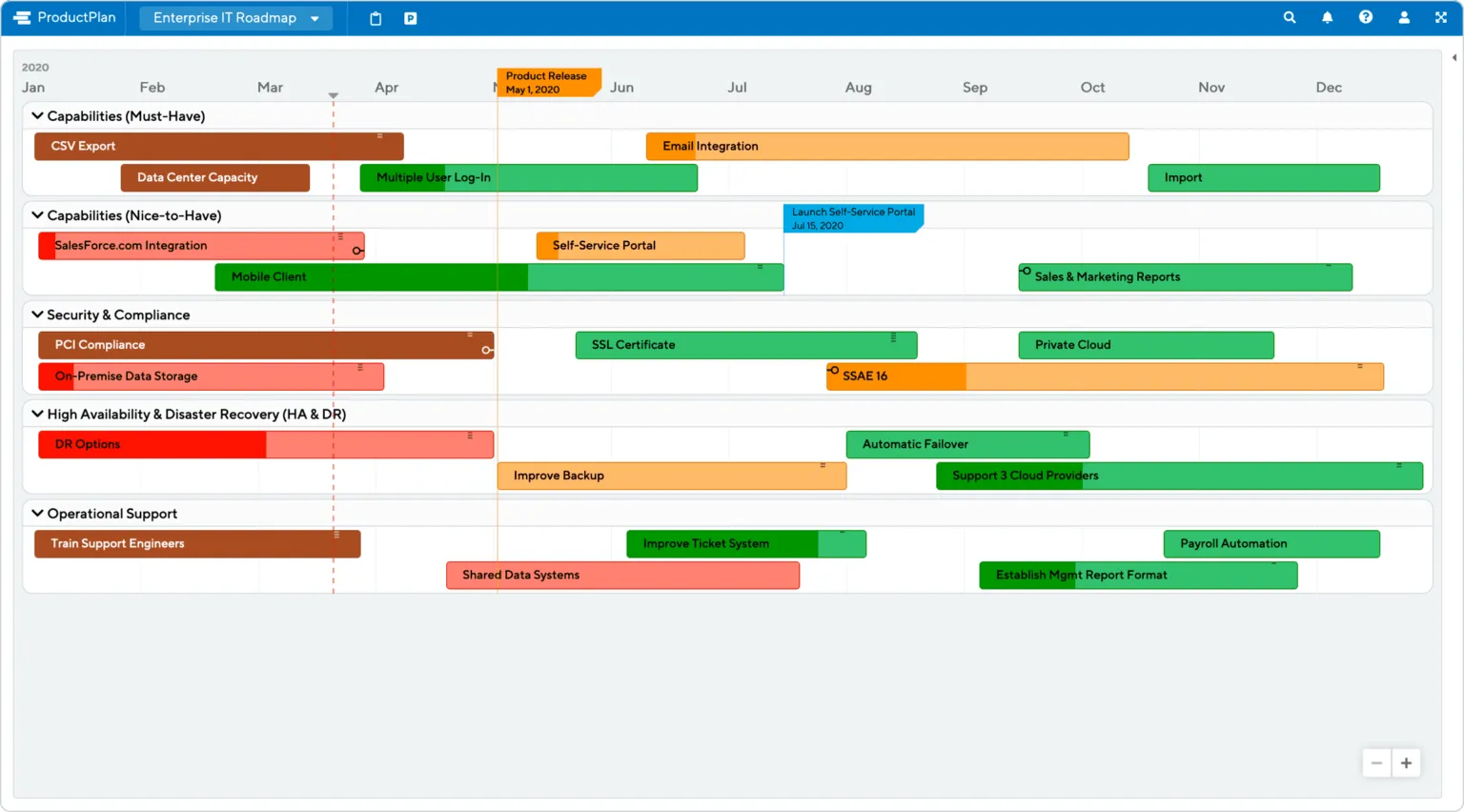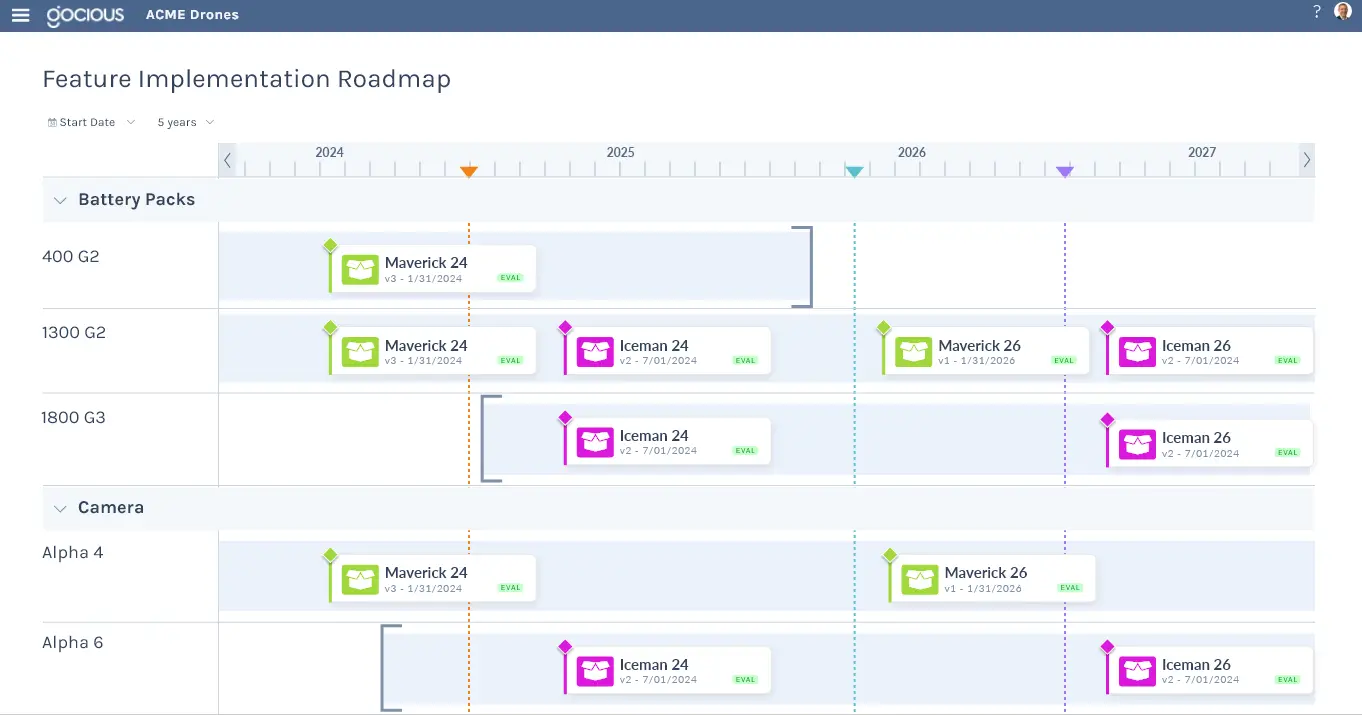Startup
Digital Product Roadmap Explained: How to Create an IT Project Strategy that Works?

Software development and implementation is full of twists and turns. Startups and established businesses working on complex software systems like ERP, CRM, or large-scale eCommerce software, can suffer from project delays, unexpected budget overruns, complex multi-stage projects, and advanced technology requirements.
The root cause? Insufficient project planning. Data shows that a staggering 55% of entrepreneurs fail in their IT projects as they overlook the crucial importance of a carefully planned strategy.
Luckily, there’s an easy way to avoid an unwanted project failure – the digital product roadmap. More than just a tech blueprint, a software implementation roadmap makes it easier to cross-share the project’s vital insights among stakeholders, outsourcing partners, and dedicated project teams, fostering clarity and collaboration.
In this guide, we will dive deep into the step-by-step process of creating an effective IT project strategy through a digital product roadmap. We will demystify the principles, tools, and techniques needed to successfully manage an outsourcing vendor partnership, creating not just a project but a platform for continuous improvement.
What Is a Digital Product Roadmap & How It Stands from Other Roadmap Terms
A digital product roadmap represents the essential tool for long-term planning, intertwining your project's objectives with your technology stack. Presented as a display, document, or diagram, it serves as a high-level visual representation of the technology elements and components of your software strategy.
Technology roadmaps outline a technology vision, goals, milestones, timelines, resources, dependencies, and risks associated with the technology initiatives. In fact, it is best to develop one before reaching out for software product development services.
Nowadays, digital product roadmap can take various visual forms, such as a timeline view, board view, item view, or chart view, providing a flexible approach to suit your specific project's needs. They can encompass timelines ranging from several months to several years, allowing you to track ongoing tech implementations, resources, redundancies, resilience, and costs associated with IT upgrades.
Technology roadmaps find their application in numerous IT projects, such as embracing new tech, software migrations, systems merging, software upgrades, and whenever it’s vital to ensure business continuity. Skipping this vital planning step can significantly increase the risk of complications down the line.
Real Example: Slack's Successful Launch through Digital Product Roadmap
Let’s consider the popular team collaboration tool Slack, their approach towards a digital product roadmap, and how it contributed to their highly successful launch.
- Market Validation: Slack founders were initially developing a gaming app, but they realized their in-house team collaboration tool (the future 'Slack') had significant potential. Market research showed that there was an urgent hunger for comprehensive, user-friendly team collaboration tools.
- Product Development: The company took a phased approach towards product development. Leveraging customer inputs, they built features that truly met user's needs. A focus on clean design and an intuitive interface were their top priorities — a strategy integral to their roadmap.
- Closed Beta Testing: Slack welcomed select organizations to use, test, and provide feedback during the beta phase. This helped Slack understand user behavior and refine the product accordingly. Slack’s decision to act on the feedback and improve was crucial to its final products’ success.
- Iterative Development: Acting on the digital roadmap, Slack developed in iterations, always focusing on delivering a better version of the product, thus enhancing customer satisfaction and engagement.
- Product Launch: When Slack officially launched in 2014, it was equipped with a robust, user-tested feature set that met the demands of its target users. Within two weeks, Slack had more than 15,000 users.
As a result, Slack became one of the fastest-growing business applications in history. Their well-devised digital product roadmap played a critical role in their successful product launch and the growth they have achieved till today.

Digital Product Roadmap vs. IT Roadmap vs. Project Roadmap
It’s easy to get confused about various terms related to project planning and spot their differences. Most likely, you’ve seen how “technology roadmaps” are interchanged to “IT roadmaps”, and “project roadmaps”. But are those terms actually equal?
Let’s give precise definitions to each term for the sake of clarity.
- First, we’re breaking down a digital product roadmap as the most project-specific term of all, offering an execution roadmap for a single software project. Project roadmaps meticulously lay out tasks, deliverables, timelines, and resources required for its successful completion delving into the "how" and "when” aspects. For the startup businesses with little market research expertise there is always an option of software product discovery services.
- With an IT roadmap, we address technology initiatives at a strategic level. Unlike the project roadmap, it delves into a detailed roadmap for product engineering services, testing processes, and strategies for data migration and employee onboarding, providing valuable tech insights for tech managers. Overall, an IT roadmap tells business owners and stakeholders what technology systems and upgrades are necessary to achieve their business goals.

- Finally, we’re looking at a technology roadmap as a more encompassing term, spanning diverse technology initiatives beyond IT. Such a roadmap implies research and development, product development, digital transformation, infrastructure, architecture, and software development.

Overall, technology roadmaps provide a comprehensive view of the organization's technology landscape, aligning investments with overarching business goals and answering the "what" and "why" of technology initiatives.
Some of the common tech roadmap types to cater to specific company needs are:
- DevOps roadmap — charts the development and deployment of software applications, emphasizing collaboration and automation between software developers and IT operations teams;
- Software design roadmap — outlines the development and release of software products or apps, highlighting features, functionality, and timelines.
- Internal IT roadmap — details technology projects supporting internal IT operations, covering software upgrades, security enhancements, and hardware replacements.
- Architecture roadmap — defines the technology architecture needed to support a company’s business goals, including hardware, software, and networking requirements.
- Infrastructure roadmap — specifies the development and maintenance of an organization’s technology infrastructure, covering servers, data centers, and networking equipment.
- Systems roadmap — explores the development and implementation of internal systems and tools supporting day-to-day operations, such as HR systems, finance systems, and project management tools.
- Hardware procurement roadmap — details the procurement and deployment of hardware equipment essential for supporting an organization’s technology infrastructure, encompassing servers, workstations, and networking equipment.
One more helpful categorization is when roadmaps are divided into product technology roadmaps and emerging technology roadmaps. The first one aids IT executives in pinpointing technologies to elevate product functions or expand the application of a specific technology. The second one is all about forecasting product development in its early stages and making further decisions as the technology develops.
Why Digital Product Roadmap Is Crucial in Software Outsourcing
Depending on its type, a digital product roadmap can serve many purposes when created and communicated at the right time. Its role extends beyond project management, and covers transparent communication, risk mitigation, and facilitated recruitment planning.
If you’re a tech leader planning to outsource your software development, a digital product roadmap is in your best interest.
By 2025, 80% of chief technology officers who use business-outcome-focused digital product roadmaps will see a 20% increase in employee and customer satisfaction scores due to better alignment of technology with business and customer needs. – Gartner.
Now, what makes digital product roadmap a vital element in software outsourcing?
Roadmaps help different teams align with the upcoming software changes.
Beyond setting timeframes and budgets, roadmaps act as navigational tools, helping different teams align with upcoming software changes. This alignment is paramount in outsourcing scenarios where distributed teams, both internal and external, need a unified direction.
By fostering transparency in company goals, system capabilities, and release plans, roadmaps ensure that all stakeholders, including outsourced teams and in-house staff, remain on the same page, despite varying involvement levels and roles.
Roadmaps align technology initiatives with long-term business goals.
The success of software outsourcing hinges on strategic alignment. A singular document can help align tech initiatives with broader business objectives.
Connecting each project to the broader goals addresses the common failure pitfalls observed in 84% of digital transformations, according to Forbes.
The roadmap carves a clear and purposeful direction, empowering stakeholders, including outsourced teams, to make smarter decisions. It promotes efficient resource allocations and creates enduring value aligned with the client's business goals.
Roadmaps set timeframes and budgets, preventing project overruns and stagnation.
Setting clear timeframes and budgets is not only about preventing overruns but also a method to promote efficient resource allocations, which is particularly vital when outsourcing to external vendors. The roadmap provides a detailed plan, including milestones, required resources, and potential roadblocks, enabling stakeholders to efficiently manage resources and dependencies. This proactive approach prevents stagnation, enhances overall project efficiency, and ensures that outsourcing engagements stay on track.
Roadmaps reinforce proactive risk management.
In outsourcing engagement, there will always be external factors and dependencies to keep an eye on. Roadmaps help anticipate future tech needs and foresee potential challenges and roadblocks empowering both the client and outsourcing teams to mitigate risks before they escalate. A shared understanding of potential risks ensures a smoother trajectory for technological implementations and minimizes disruptions to the outsourcing workflow.
Roadmaps facilitate talent onboarding and recruitment planning.
In the outsourcing scenario, where the recruitment process often involves acquiring specific skills for the project at hand, roadmaps ensure that the recruitment process aligns seamlessly with anticipated software changes. This foresight is particularly valuable when outsourcing to external teams, allowing the company to understand why they need a specific number of specialists working in the team. This prevents project overruns and ensures the right people are in the right places within the outsourced project.
And here’s to summarize: roadmaps can add the necessary structure, logic, and precision to your planning process leading to a more successful outsourcing journey with an IT development partner.
7 Key Stages to a Highly-Efficient Digital Product Roadmap
As long-time experts in software development and implementation, ElifTech believes that every success-driven project must begin with proper roadmap planning utilizing a well-structured software roadmap template. Just check out the list of ElifTech cases to count the number of successful projects released under the guidance of the digital product roadmap.
Developing a digital product roadmap that truly works isn't a walk in the park, but a systematic approach can make the process more manageable and successful. To ensure 50% of its success, consider these fundamental criteria:
- Clarity: Opting for a scannable, comprehensive, and clear-cut format ensures that each party can swiftly grasp the roadmap and make informed decisions without extra explanation.
- Realism: Setting achievable deadlines and sensible resource allocations prevents team burnout from chasing unrealistic goals.
- Agility: The trajectory of your project may shift within a year each time the market fluctuates and the business needs to evolve. Be prepared for change and employ flexible methods, to streamline this process. A dynamic software development roadmap template can help you keep track of changes in the visual mode.
The remaining 50% of roadmap success lies in the practical stages we are about to explore next:
Stage 1: Defining Project Vision & Objectives
The first stage sets a strategic and methodical foundation by establishing the project's vision and objectives. Rather than focusing solely on tasks and deadlines, the primary objective is to delve into the project's unique needs and challenges.
Ensure your enterprise technology strategy aligns with the evolving business strategy, mapping out clear connections between business and technology outcomes. For instance, using technology to boost customer service response times directly impacts customer satisfaction.
Translate this alignment into clear IT strategic plans, documenting initiatives and necessary technologies. Ask vital questions:
- What are your strategic priorities?
- What impacts do you want financially and operationally?
- How can tools empower your team and enhance customer experience?
Find ways to streamline business transactions.
Stage 2: Assessing the Current Technology Ecosystem
Once your strategic foundation is in place, the next critical step is a comprehensive technology assessment. This involves a close examination of your existing technology landscape and strategic planning for future upgrades and investments that align with anticipated business outcomes.
Look very deeply into the following aspects:
- Performance Check: Evaluate how well your current technologies support your organizational objectives. Are they up to the task, or is there room for enhancement?
- Identifying Gaps: Uncover the gaps and limitations in your current tech environment. What's holding you back, and where can improvements make a significant impact?
- Team Proficiency: Assess the skill sets and expertise of your technology team. Where are their strengths, and in what areas could skill improvement be beneficial?
Technology assessment guides decisions, prioritizes projects, and sets the direction for the digital product roadmap.
Stage 3: Adapting Roadmaps to Your TA & Stakeholders
Let's break down how to make your roadmap resonate with the people – your audience and stakeholders. Every successful software development roadmap must go through a thoughtful adaptation to people who will be using your tech product.
It makes sense to provide individual team roadmap examples based on the specific needs of each stakeholder type. This is how you can engage all stakeholders to gather diverse perspectives and weigh the pros and cons of specific projects. Modify details based on the audience, whether it's C-suite executives or different target groups, ensuring the information resonates with each audience's unique interests and concerns.
Flexibility in presentation and regular reviews, incorporating stakeholder feedback, ensures dynamic alignment and a roadmap that evolves in tandem with the organization's goals.
Stage 4: Allocating Timeline and Financial Resources
A well-planned roadmap not only details the journey but also reflects resource needs and allows adjustments whenever priorities are shifting.
Timelines serve as a reflection of resource requirements, accommodating changes in response to shifting priorities. Using the technical team's expertise to estimate effort for each task maintains consistency between leadership expectations and implementation timelines.
Realistic timeline estimation for each phase balances efficiency and quality, promoting sustainability and preventing burnout. The more effective way to specify the roadmap's timeframes is by dividing them into short-term for immediate projects, medium-term for initiatives in the next 1-3 years, and multi-year roadmaps for tech endeavors planned for 3 years and beyond.
Once there's clarity on what can be worked on, when it can be worked on, and how long it might take to implement, it’s time to clarify budget considerations. Decisions on resource allocation can influence the perceived urgency and necessity of each task. Some businesses may find it strategically beneficial to prioritize certain projects, while others might choose to defer tasks or explore alternative solutions based on their budget constraint.
Predictive financial planning not only helps determine which projects are worth the initial investment but also enhances an organization's ability to navigate unforeseen challenges with resilience.
Stage 5: Identifying Task Dependencies
It's common for certain technologies to rely on others being implemented first, creating task dependencies. Project managers need to navigate the complexities of tasks' interdependence to prioritize activities based on their urgency and importance.
Managing roadmap dependencies encompasses various forms, including:
- feature dependencies;
- technical dependencies;
- resource dependencies;
- and external dependencies (involving partners or vendors outside the company).
So how to effectively identify roadmap dependencies?
First, use your insights on the project scope, deliverables, and objectives to identify interdependent tasks. Utilize project charter templates for an initial work structure and seek insights from stakeholders, subject matter experts, and team members for a more comprehensive view.
Once interdependent tasks are recognized, establish clear relationships, specifying the nature of these relationships (e.g., finish-to-start, start-to-start) and documenting them. This step ensures a logical flow and sequence for task execution. Finally, employ effective techniques such as Gantt charts, network diagrams, etc to map and visualize dependencies within the project to facilitate clarity and smooth project execution.
Stage 6: Roadmap Visualization
Now that you've laid out your digital product roadmap background, it’s time to make it accessible and compelling. A well-structured visual roadmap becomes a shared vision, guiding your team and stakeholders toward successful technology implementation.
Optimize roadmap collaboration with outsourcing partners by employing color-coded elements for task distinction, integrating logos for milestone visibility, and ensuring clarity through timeline layers. Visualize resource allocation, spotlight partner-specific dependencies, and employ interactive features for real-time collaboration (e.g. chat integration). The ability for everyone to leave their feedback paired with analytics tools helps to understand the impact of vendor partnership within the roadmap.
Stage 7: Continuous Reviews & Updates
The final stage that brings you closer to a solid technology roadmap is about keeping yourself ready for constant technology reviews & adaptations. This approach will help you make more informed decisions about recalibrating priorities, timelines, and resources.
Every now and then, take a step back and assess your technology landscape. Is there anything new on the horizon? Have your organization's goals shifted? These periodic tech check-ups help you spot any changes affecting your roadmap.
Finally, keep all the teams involved in the loop about any updates or tweaks to the plan. This ensures everyone is on the same page about the software development strategy. Consider utilizing a proper digital product roadmap template to streamline the planning process and enhance team collaboration.
Effective Software Development Outsourcing Strategy: Tips for Success
Outsourcing software development can fast-track innovation, provide cost savings, and give businesses access to a global talent pool. However, without an effective strategy, businesses could face project delays, low-quality outputs, or data security breaches. Here are some crucial tips for developing an effective software development outsourcing strategy:
Identify Your Needs: Clearly outline the scope of the software project - from system requirements to expected functionalities. This clarity will help you find a partner who has capabilities aligned with your needs.
Example: Need - A mobile banking application with a user-friendly interface and high security.
Consider the Type of Outsourcing: Decide between onshore, nearshore, and offshore outsourcing. Evaluate considering cost, talent pool, time zone differences, and cultural nuances.
Example: Type - Nearshore outsourcing to match time zones for smoother collaboration.
Choose the Right Partner: Evaluate potential outsourcing partners for their technical expertise, portfolio, cultural fit, and customer reviews. Pricing should not be the only deciding factor.
Example: Partner - A company specializing in secure, user-friendly mobile application development.
Clearly Define Roles and Responsibilities: Ensure that both parties understand roles clearly. Set expectations for project milestones, delivery timelines, regular meetings, and updates.
Example: Role - The partner company will be responsible for design, software development, testing, and support.
Communication Strategy: Plan how you will communicate project updates, changes, and feedback with your partner. Regular check-ins, project management tools, and designated communication channels can be useful.
Example: Communication - Weekly Google Meet calls, daily summaries, use of a tool such as Jira for project management.
Track and Monitor Progress: Establish key performance indicators (KPIs) and review progress regularly. This engagement can ensure the project is on track, quality is maintained, and any issues are addressed timely.
Example: KPI - Meeting project milestones on time, no major bugs on delivery.
Ensure Security and Confidentiality: Include non-disclosure agreements (NDAs) in your contracts, ensure secure data handling practices are in place, and consider third-party audits for reassurance.
Example: Security - Signed NDAs, encrypted data transfers, regular audits.
The right software development outsourcing strategy can aid businesses in expanding capabilities, focus on core operations, and accelerate growth.
